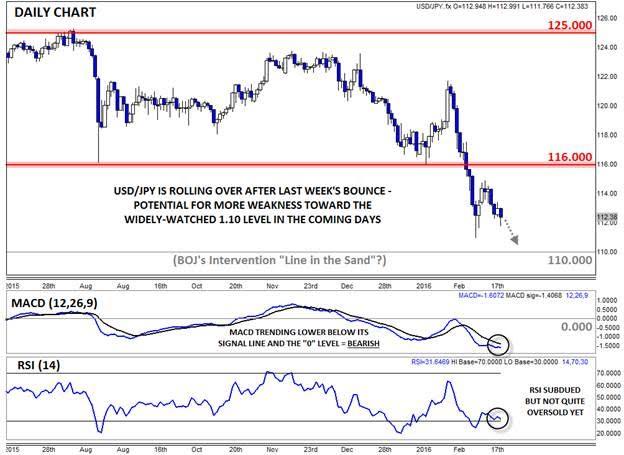![]()
It’s been a rough month for the Bank of Japan. In an effort to inject some much-needed inflationary pressures into the world’s third-largest economy, Japan’s central bank opted to join the negative interest rate club in late January, likely anticipating that it would lead to continued to depreciation in the Japanese yen as a side benefit. As it turns out, that hope couldn’t have been further from the market’s actual reaction.
The initial post-interest-rate-cut spike in USD/JPY stalled out the next day just below 122.00, and the pair has since fallen by more than 1,000 pips to a low near 1.1100 in the last four weeks. While we saw a brief oversold bounce last week, the price action so far this week suggests that the Japanese economy may be in for more near-term pain before things get any better.
Overnight, a couple of top-tier Japanese policymakers were on the wires, essentially acknowledging the recent market volatility and expressing confidence in the underlying economy, as central bankers are wont to do:
Japanese Finance Minister Aso:
G20 TO DISCUSS CHINA'S STRUCTURAL PROBLEMS, US MONETARY POLICY AND OIL PRICE DECLINES
WILL ACT FLEXIBLY ON FISCAL POLICY IF NEEDED, LOOKING AT ECONOMIC CONDITIONS
Japanese Economy Minister Ishihara:
RECENT MARKET MOVES ARE SOMEWHAT VOLATILE
JAPAN IS NOT ENGAGED IN COMPETITIVE CURRENCY DEVALUATION
Bank of Japan Governor Kuroda:
EXPANSION OF BASE MONEY ALONE WON'T IMMEDIATELY PUSH UP PRICES, INFLATION EXPECTATIONS
KEY TRANSMISSION CHANNEL OF QQE IS TO PUSH DOWN REAL INTEREST RATES
IT'S TRUE INFLATION EXPECTATIONS HAVE BEEN SOMEWHAT WEAK RECENTLY
IN LONG RUN, INFLATION EXPECTATIONS ARE RISING
MUST CONTINUE QQE WITH NEGATIVE RATES UNTIL INFLATION IS SUSTAINABLY ABOVE 2 PCT
Far more than the overnight attempts at jawboning though, the value of the yen is being driven by global risk sentiment. With major European and Asian equity indices ticking lower, we’re seeing a kneejerk flow of capital toward USD/JPY.
Turning our attention to the chart, USD/JPY is on track for its lowest close since October 2014. It now appears that the early week oversold bounce is well and truly behind us, and bears may look to push the unit lower in the coming days, especially if risk sentiment remains weak. The secondary indicators also point toward the potential for more weakness, with the MACD trending lower below both its signal line and the “0” level, while the RSI indicator is subdued, though not quite oversold yet.
At this point, the biggest risk to the short-term bearish outlook is the potential for intervention by the Bank of Japan. The last time we saw persistent safe haven demand for USD/JPY back in 2010-11, the Bank of Japan intervened to (temporarily) drive the pair sharply higher on four separate occasions, thought the USD/JPY rallies were quickly reversed. This time around, traders and analysts feel that the risk of intervention will rise dramatically if/when USD/JPY approaches the 1.10 level, so readers may want to keep an eye on that key level.
As is always the case, there are risks to any outlook, but from a purely technical perspective, it looks like USD/JPY bears are regaining the upper hand after last week’s bounce.
This research is for informational purposes and should not be construed as personal advice. Trading any financial market involves risk. Trading on leverage involves risk of losses greater than deposits.
Recommended Content
Editors’ Picks
EUR/USD clings to gains above 1.0750 after US data

EUR/USD manages to hold in positive territory above 1.0750 despite retreating from the fresh multi-week high it set above 1.0800 earlier in the day. The US Dollar struggles to find demand following the weaker-than-expected NFP data.
GBP/USD declines below 1.2550 following NFP-inspired upsurge

GBP/USD struggles to preserve its bullish momentum and trades below 1.2550 in the American session. Earlier in the day, the disappointing April jobs report from the US triggered a USD selloff and allowed the pair to reach multi-week highs above 1.2600.
Gold struggles to hold above $2,300 despite falling US yields

Gold stays on the back foot below $2,300 in the American session on Friday. The benchmark 10-year US Treasury bond yield stays in negative territory below 4.6% after weak US data but the improving risk mood doesn't allow XAU/USD to gain traction.
Bitcoin Weekly Forecast: Should you buy BTC here? Premium

Bitcoin (BTC) price shows signs of a potential reversal but lacks confirmation, which has divided the investor community into two – those who are buying the dips and those who are expecting a further correction.
Week ahead – BoE and RBA decisions headline a calm week

Bank of England meets on Thursday, unlikely to signal rate cuts. Reserve Bank of Australia could maintain a higher-for-longer stance. Elsewhere, Bank of Japan releases summary of opinions.
